The butternut squash is a winter vegetable that grows to a weight of 2–3 pounds and looks a lot like an out-of-shape bowling ball. Although used as a vegetable in cooking, this variety of squash is actually a fruit that grows on a vine. It thrives on sunshine and, over the summer and autumn months, develops a flavor and texture that’s suited to soups, roasting, boiling, sautéing, and stuffing, and it makes a delectable puree to add a vibrant shade of yellow-orange to the plate.
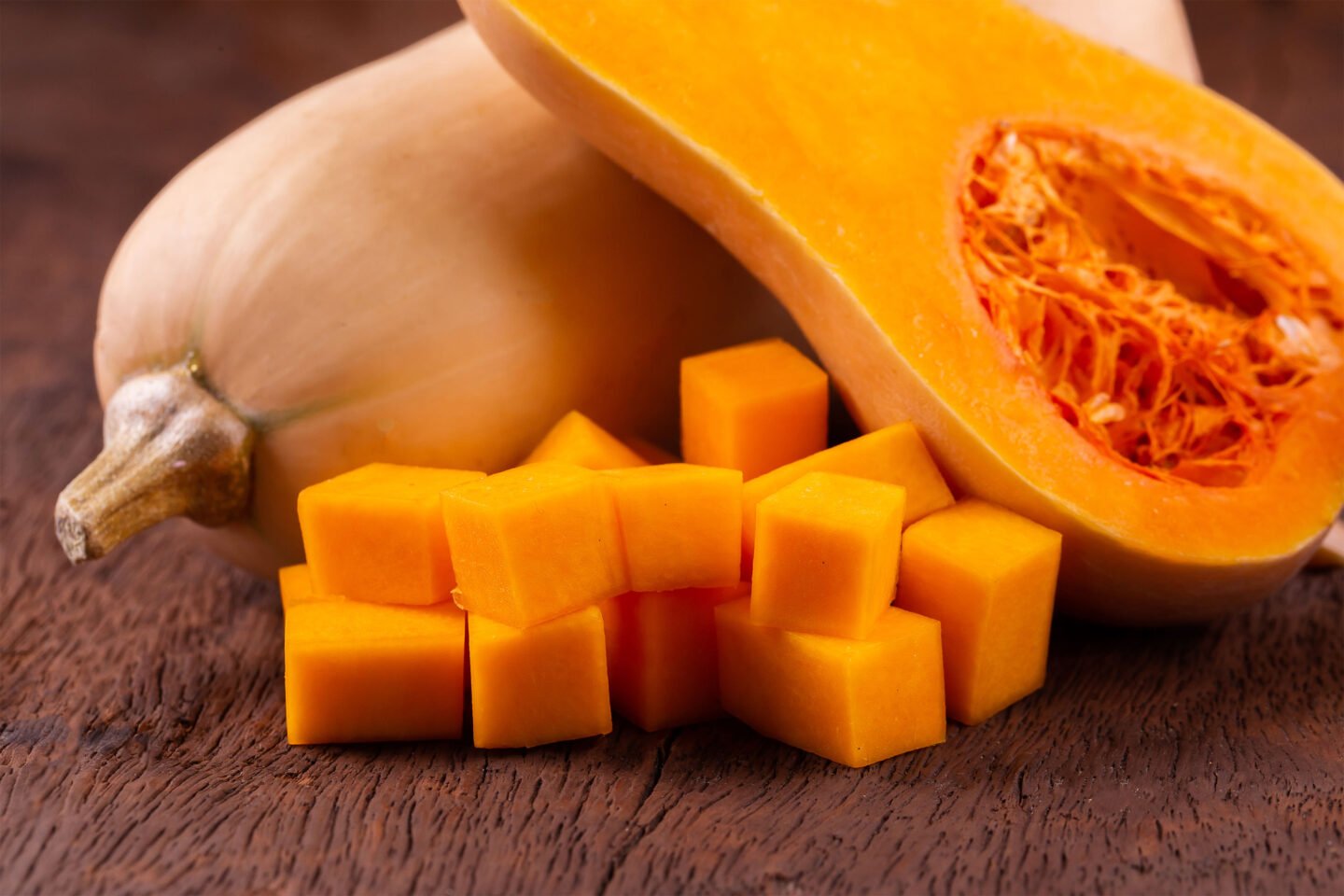
If you’ve never tasted one before, you’re probably wondering what does butternut squash taste like? We’ll answer that question as well as look at preparation steps, storage, substitutes, and more.
Table of Contents
Butternut squash: how does it taste?
Butternut squash has vivid yellow-orange flesh that is sweet and savory rolled into one with a mild nutty undertone. Its texture, once cooked, is soft and moist and almost melts in the mouth. When compared to other ingredients, some liken it to a sweet potato or carrot. However, its water content is 86%¹ whereas a sweet potato is only 73%, which results in very unique textures.
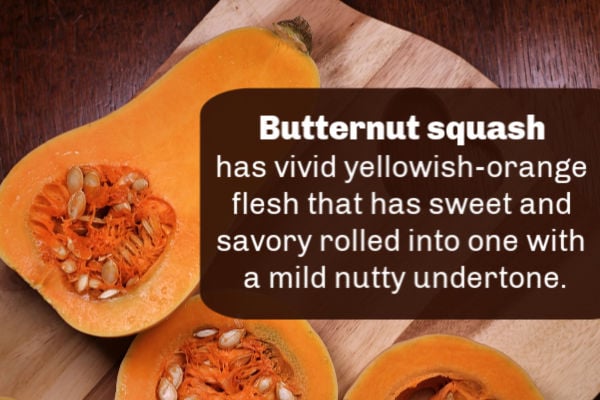
The outside of a butternut squash is a tan-colored skin that is relatively soft and thin when compared to a pumpkin. However, it does thicken as it grows in size, and extra-large fruit will become tough. Although the skin is edible, we recommend peeling it and discarding it before cooking. Once cooked, it can still be a challenge to bite through, and the texture doesn’t add much to the dish.
Does it taste okay raw?
Raw squash is edible, but it is recommended to cook it to enhance the flavor and soften the texture. The raw version has a similar taste to the cooked one, only the flavor is milder. Cooking brings out the sweetness, especially when roasting and sautéing, thanks to the Maillard reaction².
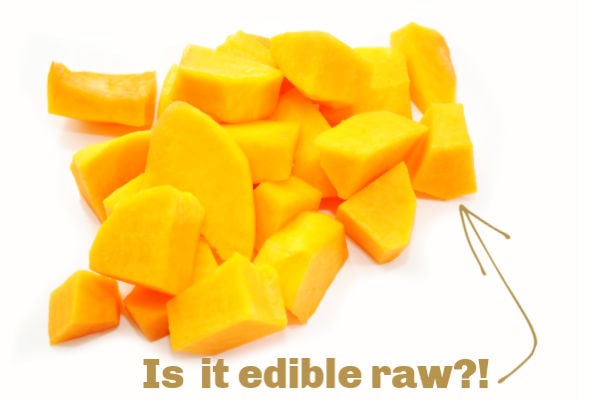
If you choose to eat your squash raw, then avoid eating it in chunks, as the texture is simply too firm. Instead, grate, spiralize, or thinly slice using a sharp kitchen knife or mandolin. Eat it as a seasoned side dish or toss it into a salad for something different.
Can you eat the seeds?
The seeds of butternut squash are perfectly edible; they’re quite large and flat, with a nutty taste that is enhanced when toasted lightly. Like pumpkin seeds, they contain protein and nutritious heart-healthy fats³. Use them for a snack on the go, in cereal, or seasoned and sprinkled over a main course for a visual effect.
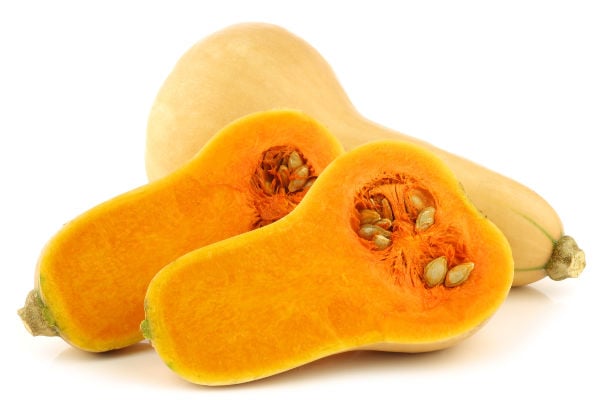
Comparing the flavors of winter squash
| Variety | Flavor |
|---|---|
| Acorn | Mildly nutty and sweet. |
| Banana | Meaty firm flesh and earthy, fragrant taste. |
| Buttercup | Sweeter than other winter squash varieties, compares to sweet potato. |
| Delicata | Sweet and rich flavor profile similar to sweet potato. |
| Hubbard | Sweet and rich flavor similar to a pumpkin. |
| Kabocha | Nutty and very sweet, a cross between sweet potato and pumpkin. |
| Spaghetti | Mild flavor without the sweetness. Tender chewy texture. |
| Sweet dumpling | Sweet taste similar to corn. |
| Turban | Nutty, mild flavor with a soft, floury texture. |
What foods pair well with butternut squash?
Seasoning
Seasoning that works well with pumpkin will also combine nicely with butternut squash. Consider using aromatic herbs such as cinnamon, nutmeg, oregano, basil, rosemary and tarragon.
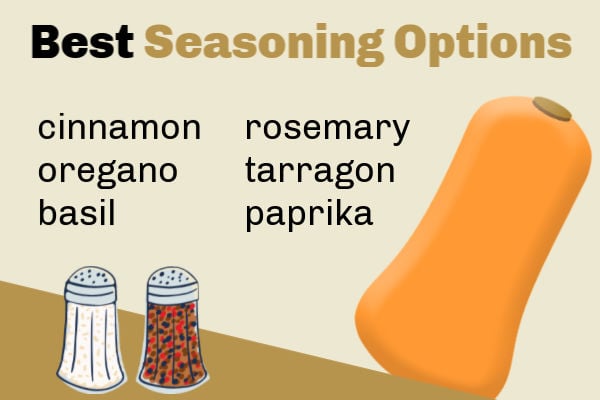
Salt, pepper, garlic and hot spices like cayenne or paprika are also good options.
Protein
Any meat will marry well with butternut squash although some work better than others. Choose slightly mild tasting meat such as pork or chicken. These options also have a hint of sweetness to them which is delicious. Add squash to any casserole or slow-cooked meal to balance out the heavy, umami meat flavors with some sweetness.
Drinks
Pair your dish with a refreshing Chardonnay, Riesling, or a Chianti
Related reading: What are the best delicata squash substitutes?
The benefit of squash vs pumpkin
In the U.S. pumpkins have ruled in the kitchen for decades. Why would you choose to buy a butternut squash instead?
- Its size is often a lot smaller than a pumpkin making it easier to carry, store and eat before it goes off.
- Pumpkins can be relatively expensive when you take into account their size.
- Preparation is a lot more manageable thanks to its size and elongated shape. Having thinner skin than a pumpkin makes it a safer ingredient to chop.
- It’s full of vitamin A and one cup contains only 63 calories and 3.1g of sugar.
How to choose the best
As with any fruit or vegetable, choosing the healthiest freshest squash on the pile will improve your final dish – sometimes significantly.
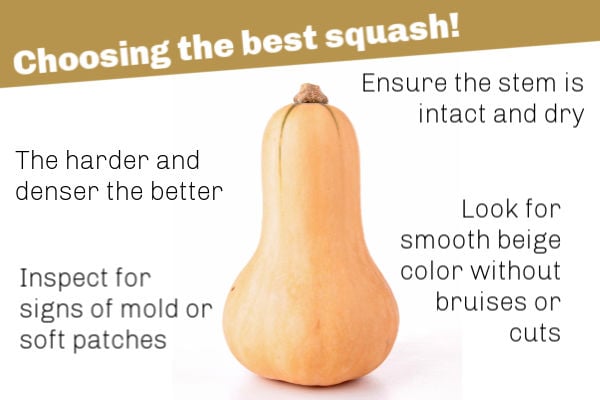
- Check the skin and look for a smooth beige color without bruises.
- Hold the fruit in your hands; it should feel surprisingly weighty
- The harder and denser the better – scratching the skin should be difficult
- Look for any cuts or signs of damage; minor surface scratches are fine
- Inspect for signs of mold or soft patches.
- Ensure the stem is intact and dry.
How to store
Butternut squash should be stored in a cool, dry position (50-60°F) away from sunlight; the basement or garage is a good option. Leave the squash uncut until it comes time to cook it. In the right conditions, a butternut squash will keep for up to six months.
Avoid refrigerating uncut squash as the texture of the flesh softens and becomes unpleasant. Once cut, place leftover pieces in an airtight container or bag and refrigerate. To extend the life of squash, cook it then wrap in aluminium foil and freeze for 6-12 months.
What does butternut squash taste like when it goes bad?
Butternut squash that has gone off won’t change its flavor a great deals; however, its texture will rot and become inedible. It is easy to spot squash that has gone off as it will no longer be firm. Often, you can cut off the edges which are showing signs of mold and eat the remaining fruit.
Preparation
What you’ll need: chopping board, large kitchen knife
- Slice off the stem and discard.
- Cut the squash in half lengthways.
- Scoop out the seeds and fiber then discard or set aside for toasting.
- Peel off the skin using a knife or peeler.
- Cut into suitable sized pieces
Tip: If you want to make life easier during vegetable prep time then use a knife that's designed for making the job easy. Two of our favorites are the usuba and nakiri knife, two very sharp Japanese kitchen knives; but which is the best? Check out our comparison of these two knives and you'll discover which is best for you.
Cooking options
Butternut squash is a robust, versatile ingredient that is simple to cook using a variety of methods.
Roasting
A crowd pleasing favorite, simply slice into half-moon pieces or 1” cubes then place on an over tray and drizzle with olive oil and seasoning of your choice. Bake for 350°F (180°C) for 30 minutes or until tender.
Microwaving
Cut into your pieces of your required size and layer on a large plate and cook for 5 minutes. Check to see if cooked and, if necessary, continue cooking at 2 minute increments until softened. You can also cook an entire squash in the microwave if it fits. Remember to make some slits in each side with a knife to allow steam to escape. Once cooked, you can slice it open and remove the seeds but be careful of the hot steam that will have built up inside.
Boiling
Slice the squash into pieces and place in a saucepan of cold, salted water. Bring to boil then reduce to simmer and cook for 15 minutes or until tender. This cooking method (and microwaving) is ideal for creating puree, whether you want it for baby food or to add some color and texture to your next dish. To create a puree add the squash to a suitable, high-walled container and process with an immersion blender, aka stick blender.
Baked
The shape of butternut squash is ideal for stuffing with a range of your favorite fillings. Leave the squash with the peel on and slice in half, length ways. Microwave until the flesh is soft then scoop out the insides. Combine the flesh with salt, pepper, garlic, bell pepper, onion, rice, and chili then spoon back into the squash casings. Top with cheese and bake on 350°F (180°C) for 20 minutes.
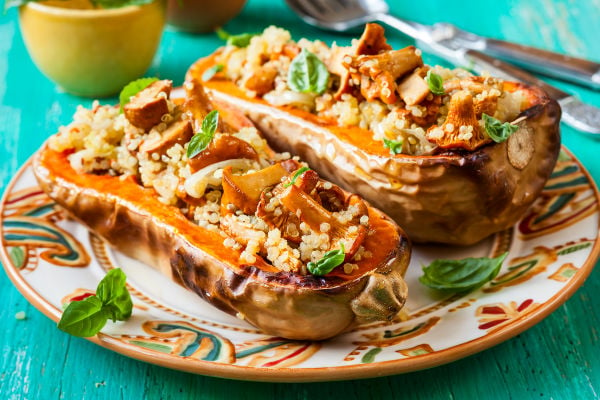
Substitutes for butternut squash
If you’re looking to replace the squash in a recipe then consider the following alternatives:
- Sweet potato
- Parsnips
- Potatoes and carrots
- Pumpkin
- Acorn, buttercup or hubbard squash
Which is better butternut squash or sweet potato?
Whether you prefer squash or pumpkin will come down to personal preference. Both options offer a pleasant sweet taste that is good for balancing meals with salty meat. The big difference is the texture: sweet potato is drier and starchier and certainly is the more filling choice. Squash is more versatile: delicious on its own, pureed or as a soup.
Final Words
If you’d like to know how butternut squash tastes then I’d say it has a moist, soft texture combining a mix of sweet and savory flavor in each mouthful. There are no surprises here folks so don’t expect a shock of bitter like you’d get from rapini or unique aniseed flavor that you’d get from fennel. Butternut squash is a mild tasting, sweet, earthy winter vegetable and likely to be enjoyed by even the fussiest eater.
References:
[1] https://harvesttotable.com/watering_and_water_content_of/
[2] https://www.scienceofcooking.com/maillard_reaction.htm
[3] https://oureverydaylife.com/270654-butternut-squash-seeds-nutrition.html

Leave a Reply